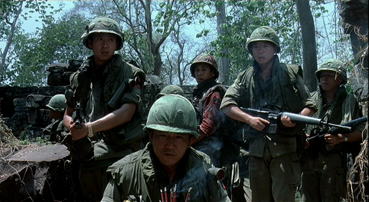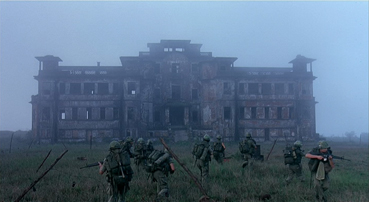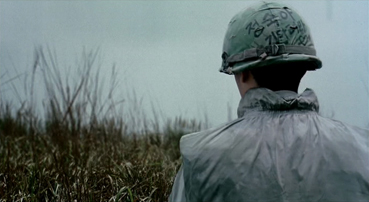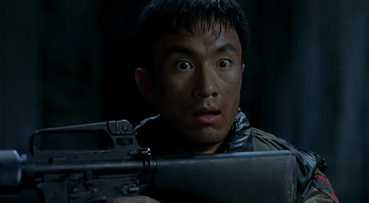|
Title changes seem to be in vogue at the moment, at least for less widely seen genre movies. A couple work rather well – the upcoming Dear Mr. Gacy has been switched to the more suggestive The Last Victim, which was also the title of the book on which it was based. But far too many of the replacement monikers appear to have been devised to spell out the content for an audience that buy or rent films on the basis of the DVD cover rather than anything they've heard about the film in question. Which is how the 2003 Korean cross-genre movie R-Point has finally arrived on UK DVD as Ghosts of War. You see, it's set in a war zone, and there are ghosts in it. The ghosts of soldiers. The ghosts of war. Hmm.
What is a little annoying is that R-Point actually has a bit of a rep, being the first war/horror crossover movie by director Kong Su-chang, who continued in a similar vein with the 2008 GP506 (which also underwent a title change to Guard Post, of course), which was released on UK DVD and Blu-ray in 2008 by Cine Asia. But having precured the UK distribution rights and changed the title, Palisades Tartan have struck a peculiar deal to release Ghosts of War, aka R-Point, exclusively through Sainsbury's stores, not the first place you'd look for a subtitled Korean horror flick.

Anyway, the title's been changed, it's tucked between the big Hollywood releases at Sainsbury's, but what exactly is R-Point about? It all kicks off at a South Korean military base in Vietnam in 1972, where a rasping radio message is received from an army platoon that has been missing for six months and presumed dead, a message that ends in gunfire and shouting. Just what has happened here? Ordered to investigate their fate is respected and decorated veteran Lieutenant Choi Tae-in, who takes an eight-man platoon to the remote island where the missing soldiers vanished. They've not been there long when they discover a tombstone telling of a past Chinese massacre of Vietnamese, whose burial place has become the site of a now-ruined temple. Unimpressed by a warning about the fate that awaits those with blood on their hands, one of the soldiers urinates on the tomb. Oh, if only he knew he was in a horror movie. After a night in the open they make camp in an abandoned French plantation mansion, where strange and unsettling events start to occur.
There's nothing too original or surprising in this setup. Assemble a group of people, transport them to somewhere alien and isolated, expose them to a warning that they choose to ignore, then wait for the bodies to start piling up. And yet by swapping fun-loving teenagers for soldiers on a mission and shifting the location from an isolated party house to the backwoods of war-torn Vietnam, it feels a lot fresher than the above summary suggests. It helps that director Kong refuses to take the blood and thunder approach, preferring instead the seduction of the slow build and spending time getting to know the soldiers before spooking us out.
A couple of attempts at cheap false-alarm shocks fit uneasily with an otherwise understated approach, with the isolated locale and Kong's fondness for ominously scored camera drifts building an unsettling sense that there really is something unnatural lurking out there in the dark. Where he really delivers is in carrying this through into the revealing glare of daylight, something eerily demonstrated when Corporal Joh becomes separated and encounters a group of ghostly soldiers that he initially mistakes for his comrades. While there's nothing overtly supernatural about them – no hollowed-out faces or rotting clothing here – their colour-drained uniforms, oddly slow movement and refusal to acknowledge Joh's presence (we and he only see them from behind) gives them a creepily unearthly aura. Kong also proves a master of the bone-chilling wide shot, with the platoon's waking discovery that they've camped a mere stone's throw from the abandoned plantation building (a superbly atmospheric exterior location) creating the sense that it has somehow risen from the ground overnight, while the lightning flash that exposes the mass graveyard into which Choi has unknowingly wandered is such a superbly executed reveal that it still made me draw breath a second time around.

As the supernatural encounters begin to pile up, Kong's willingness to throw in just about every horror trick he's seen does not always score – the radio that oozes blood is a hackneyed device, Sergeant Jin's approach and discovery of a dead radio operator is lifted directly from Psycho, and the too-familiar figure of the long haired, white-clothed oriental girl pops up like she's making a cameo appearance, despite her solid-enough integration into the storyline. Better by far are the borrowings from The Thing (and to a degree Reservoir Dogs), as an unseen spirit with its own POV camera style wanders from soldier to soldier in search of a host and the troops become unable to distinguish the living from the dead, which sees their actions become dictated as much by paranoia as their increasing fear of what lies beyond the plantation door.
R-Point is a medley of original ideas and borrowed material, but Kong assembles them into a surprisingly seductive whole. In its engagement with character and its preference for suggestion over explicit horror, it has a real edge over its subgenre successor and its best scenes easily eclipse those of Kong's fiollow-up movie. Atmospherically shot and scored, it's a must-see for fans of Eastern horror, and one that so far has thankfully escaped being swallowed up by the Hollywood remake machine.
One thing you don't do with an NTSC to PAL transfer is edge enhance it, and if you want to know why then you'll find visible evidence here in the shimmering of fine detail and the transformation of denser foliage into a sometimes jumbled mess. The thing is, the picture probably looked fine without it, as in other respects this is a respectable transfer, with a decent level of detail, well balanced contrast and solid blacks. Some minor judder is evident on camera movements (and, strangely, a couple of static shots), but it's that over-enhancement that makes the transfer less than it should have been. As is becoming common of late, the colour has been partially desaturated, a deliberate artistic decision rather than an issue with the transfer, which is slightly windowboxed at 1.85:1 and anamorphically enhanced.

Soundtrack-wise, you can choose between the old Tartan trio of Dolby 2.0 stereo, Dolby 5.1 surround and DTS 5.1 surround, all in the original Korean, with or without subtitles (although Korean subtitles remain on the few English-spoken scenes). Sonically, there's little to choose between the three, but the inclusive use of the full sound stage gives the surround tracks the edge, though neither are as sprightly as the Korean norm – the early forest fire-fight makes surprisingly little use of the surrounds or the LFE bass, even on gunfire and explosions. Clarity is great on sound effects and music, though not quite as polished on dialogue, with the mumbled English spoken by the visiting American soldiers hard to clearly make out unless the volume is turned up.
Commentary
It's rare to find a subtitled commentary on the UK DVD release of a Korean movie (usually you have to be of Park Chan-wook's stature to receive such an honour), but that's what we have here, and it's most welcome. Director Kong Soo-chang, producer Choi Kang-hyuk and the location supervisor for Cambodia Kim Wan-shik look back at the making of film (I'm not sure when this was recorded, but the trio remark that it's been some time since they last saw it) with a pleasing lack of ego and are not above criticising elements they are retrospectively unhappy with. The expected areas are covered, including the locations, the actors, the characters and the story structure, but we also get plenty of anecdotes about the shoot, from having to pay bribes to be allowed to film at one Cambodian location to the problems caused by an infestation of bees. It's hard to tell just who is talking at any one time, but one of the trio suggests that he hated being alone in the plantation mansion, where a number of people were killed under the Pol Pot regime.
Mission R-Point – Making of (30:19)
An unhurried but interesting making-of featurette that includes the usual mix of behind-the-scenes footage and interviews with the actors and filmmakers. The decision to move the production from Vietnam to Cambodia is covered, and director Kong wishes he could have included an epilogue, which would, he believes, "have answered a lot of the audience's questions." The toughness of the shoot – particularly the heat and the jungle location – are touched on, and there is some coverage of the make-up effects work, which is expanded on below.

Broken Radio (13:18)
An unnamed sound editor talks about the sound mix of the climactic scene and plays the sequence three times with different mixes; Foley artist Ahn In-bom talks a little about his work and demonstrates the process by walking on a dirt box wearing uniform and equipment; and sound editor Lee Soon-young discusses lip-synching ADR dialogue to the edited footage.
1972, Vietnam (10:00)
Props man Hwang Joong-hun talks about researching, locating and transporting required props for the period and locale, some of which they were unable to get through customs (a problem touched on in the commentary as well), with some props created on location from scratch because the local equivalent was apparently "awful." He also talks about the creepiness of the mansion location, but assures us he never saw a ghost. Unlike some others, apparently...
Special Effects featurette (9:59)
Make-up effects artist Lee Chang-man reveals his excitement at working on a film with so many dead bodies and discusses the technical issues of a blood-in-the-face shot and some of the other make-up effects. He has a couple of interesting anecdotes about corn syrup and inquisitive local kids, looks back without affection at the living conditions and the food, and like others (the director included) expresses disappointment for sequences that didn't quite come together as planned.
Original Trailer (1:52)
The original Korean pre-release trailer under the title R-Point – creepy enough, but with a couple of spoilers.
In a back-to-front world, R-Point would be the film that delivers on the promise shown by GP506, being very much along the same lines and employing three of the same actors. Except, of course, R-Point was made first, and while not the first war/horror crossover – the 2002 Deathwatch has the jump on it by two years – has allowed writer-director Kong Su-chang to create a small niche for himself that has yet to result in a third feature of any genre. Tartan Palisade's DVD does very well on extras, but that enhancement takes the edge off what is otherwise a decent enough transfer.
|